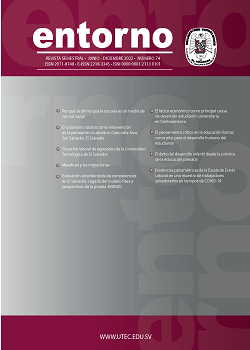Tactical urbanism as a means of intervention in citizen perception. Case: Calle Arce, San Salvador, El Salvador
Published 2023-08-30
Keywords
- Land use – Planning,
- Urban rehabilitation – El Salvador – Social aspects,
- Urban community development,
- Ethnology – El Salvador
Copyright (c) 2022 Entorno

This work is licensed under a Creative Commons Attribution-NonCommercial-ShareAlike 4.0 International License.
How to Cite
Abstract
Recently, the possibility of applying alternative processes to traditional urbanism has been explored, which are low cost and open space to the processes of inclusion of the citizen in the urban environment. This article presents some elements that are part of the institutional research project of tactical urbanism and whose objective was to investigate the behavior of pedestrians in the public space of Calle Arce and their reactions to the intervention carried out in the space between 17th and 19th avenue in the city of San Salvador. The project was triggered by the intervention initiative proposed by the urban observatory Imagina Lab of Glasswing International in coordination with the Department of Urban Revitalization of the Municipality of San Salvador. The collective participation in the design and execution of this public space was possible thanks to the partnerships that contribute to the achievement of the Sustainable Development Goals in order to subsequently observe the behavioral changes of citizens in relation to the outcome of the project. This experience is the first exercise of this kind in the context of the surroundings of a university campus in El Salvador. The experience made it possible that, for a couple of months, the street served as a canvas and framework for more activities that activated the surrounding urban public space. Finally, a systematic observation of the intervened environment was used to analyze people’s reactions to the projects; such analysis was carried out in four different categories of analysis through which an initial resistance to change and an urgency to generate more adequate public spaces for the community were interpreted. The records will serve as background information, which may be useful for further participatory urbanism interventions in the future.

